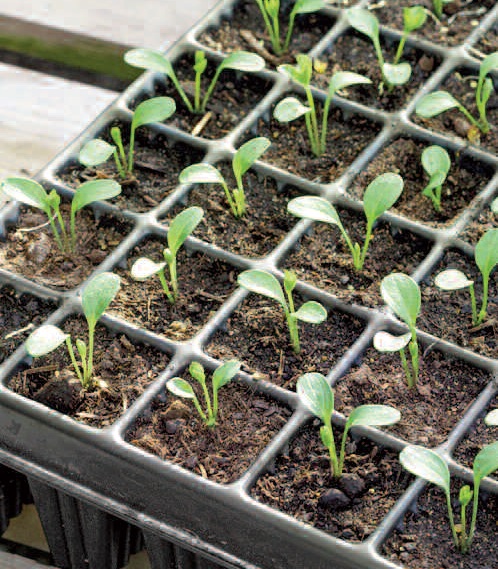GARDEN WORKS: EXTEND SUCCESS! Start long-season plants now for best results
GARDEN WORKS
 by Emily Cates
by Emily Cates
Part 1 of 2
Are you really, really looking forward to the promise of springtime? I am. The biting cold wind battering the frozen ground has given way to a warming breeze beckoning in aromas of thawing soil. As the heady scent of freshly defrosted mud entices my nostrils, I am hurled into an awakened state where I feel an urgent need to start seedlings. If you find yourself similarly inclined, why not read on? Since our area has a limited amount of frost-free days, plants that take a while – such as tomatoes, peppers, eggplant, leeks, onions, artichoke, and many more herbs, flowers, and the like – will have a greater chance of success if started indoors now. In this two-part article, let’s explore a few practical suggestions on starting long-season plants. This time we’ll look at lighting setups, substrate, suitable containers, watering, and climate-control.
First, the lighting setup. This could be as simple as a sunny, south-facing windowsill, a unit of grow-lights, or the luxury of a sun room or heated greenhouse. To prevent seedlings from becoming leggy once they’ve sprouted keep the containers as close to the lights as possible without burning the plants.
 A second ingredient to successful seedlings is the substrate. Always remember to use organically-produced, fresh, pest and disease-free planting medium, whether purchased or homemade. Products that support germination are fine-textured and oftentimes do not contain soil. (These are especially helpful for starting small seeds.) Examples are peat, coir, vermiculite, etc. When purchasing bags of medium, look for those specifically formulated for germination. (Later on, when transplanting, we’ll use a coarser mix with organic matter to provide nutrition for the growing plants- but for now we’re just interested in germination.)
A second ingredient to successful seedlings is the substrate. Always remember to use organically-produced, fresh, pest and disease-free planting medium, whether purchased or homemade. Products that support germination are fine-textured and oftentimes do not contain soil. (These are especially helpful for starting small seeds.) Examples are peat, coir, vermiculite, etc. When purchasing bags of medium, look for those specifically formulated for germination. (Later on, when transplanting, we’ll use a coarser mix with organic matter to provide nutrition for the growing plants- but for now we’re just interested in germination.)
Another important component is a clean, well-drained container that holds the substrate. Possible candidates could include free and abundant used yogurt cups from home or the recycling center. Wash them well and poke holes in the bottoms, label them, fill with planting medium, and they’re good to go! Also, there is this handy dandy little tool called the “pot maker” which you can use to make countless amounts of pots out of plain newsprint. If expense is not an issue and the desire is aesthetic, go for the plastic flats and 6-packs and such found in seed catalogs and gardening centers. Seeds can be individually or collectively sown in smaller containers, but the resulting seedlings are easier to transplant if they are in flats or containers with a larger surface area. With this in mind, you might want to check out soil block makers, which form blocks of soil which can be placed next to each other in a tray and seeded. They are easy to work with, as the roots are “air pruned” as they grow long, making transplanting the seedlings a cinch.
Besides containers, we’ll also want to think about an acceptable source of water. Watering with plain tap water is fine as long as it’s not chlorinated or softened; use filtered water if there is any question. Keep the seeds and seedlings moist, but not waterlogged. If necessary, additional draining holes in the container can be poked through or drilled. Conversely, a clear cover of some sort can be placed over the container to conserve moisture – just check daily to make sure it can breathe.
Temperature is another factor of importance. 80 degrees F and above are necessary for proper germination, so a heat mat or other source of warmth could be used in a cold room. Elaborate climate-controls are highly effective, but potentially expensive. These are especially advantageous in a greenhouse or grow-light systems where the temperature has the tendency to fluctuate or get too hot. A simple oscillating fan is a useful, low-cost possibility. Get even fancier by hooking it up to a thermostat switch that flips it on when it gets above a certain temperature!
So, I hope this is enough info to get you started. I should mention that you can find as much of these indoor-gardening supplies as you’ll need at LaVerdiere’s General Store in China Village. Also, check out FEDCO and Johnny’s as well. Stay tuned for next time!
Responsible journalism is hard work!
It is also expensive!
If you enjoy reading The Town Line and the good news we bring you each week, would you consider a donation to help us continue the work we’re doing?
The Town Line is a 501(c)(3) nonprofit private foundation, and all donations are tax deductible under the Internal Revenue Service code.
To help, please visit our online donation page or mail a check payable to The Town Line, PO Box 89, South China, ME 04358. Your contribution is appreciated!


Leave a Reply
Want to join the discussion?Feel free to contribute!